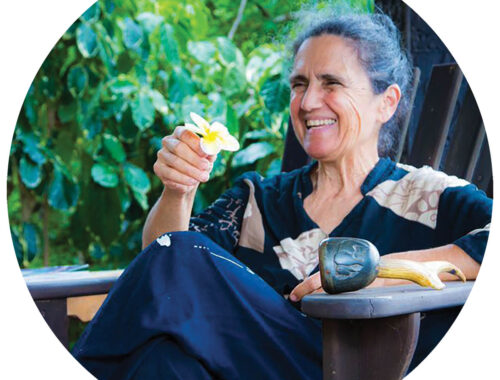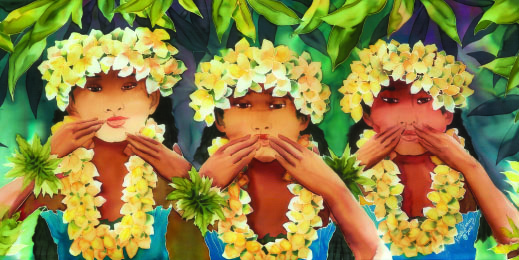
Dancing in the Light: Visions on Silk by Kristi Kranz
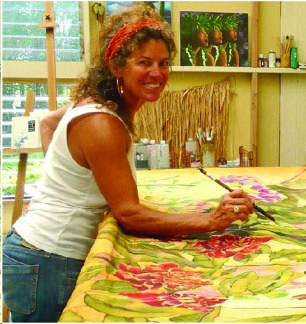 By Karen Valentine
By Karen Valentine
A gossamer weave of silk, light as light itself, dances in the morning sun. Stretched between two sawhorses at the studio of artist Kristi Kranz, it awaits the perfection of a completed image, born of the visions that float in the artist’s imagination. Liquid color, poised on the tip of her brush, kisses the silk, spreading into a cloud as the fabric absorbs the dye and lets it go where it will. In other places, the color stays confined inside an outlined image that the artist has drawn onto the silk with a gummy substance, called gutta, to corral the colors.
Kristi Kranz’ paintings on silk are a luxurious marriage of fabric and color—the blend of colors and texture forming the image, while the translucent silk allows the light to express itself subtly as part of the finished painting.
The North Kohala artist’s brilliant silk paintings make you think of watercolors, the art form to which she was first attracted and studied at The Anderson Ranch Center for the Arts in Snowmass, Colorado. But, as her art has evolved, she now finds more challenge and more exclusivity in silk painting. Kristi clearly enjoys what she does.
“Silk is fabulous,” she said. “When I got my first bolt [of silk], I wrapped it around me. It’s sensual. The white silk is a blank page, but not like paper. It’s shimmery and translucent.”
It’s been a journey of twists and turns that have led her to becoming the top-selling artist for one Kohala gallery.
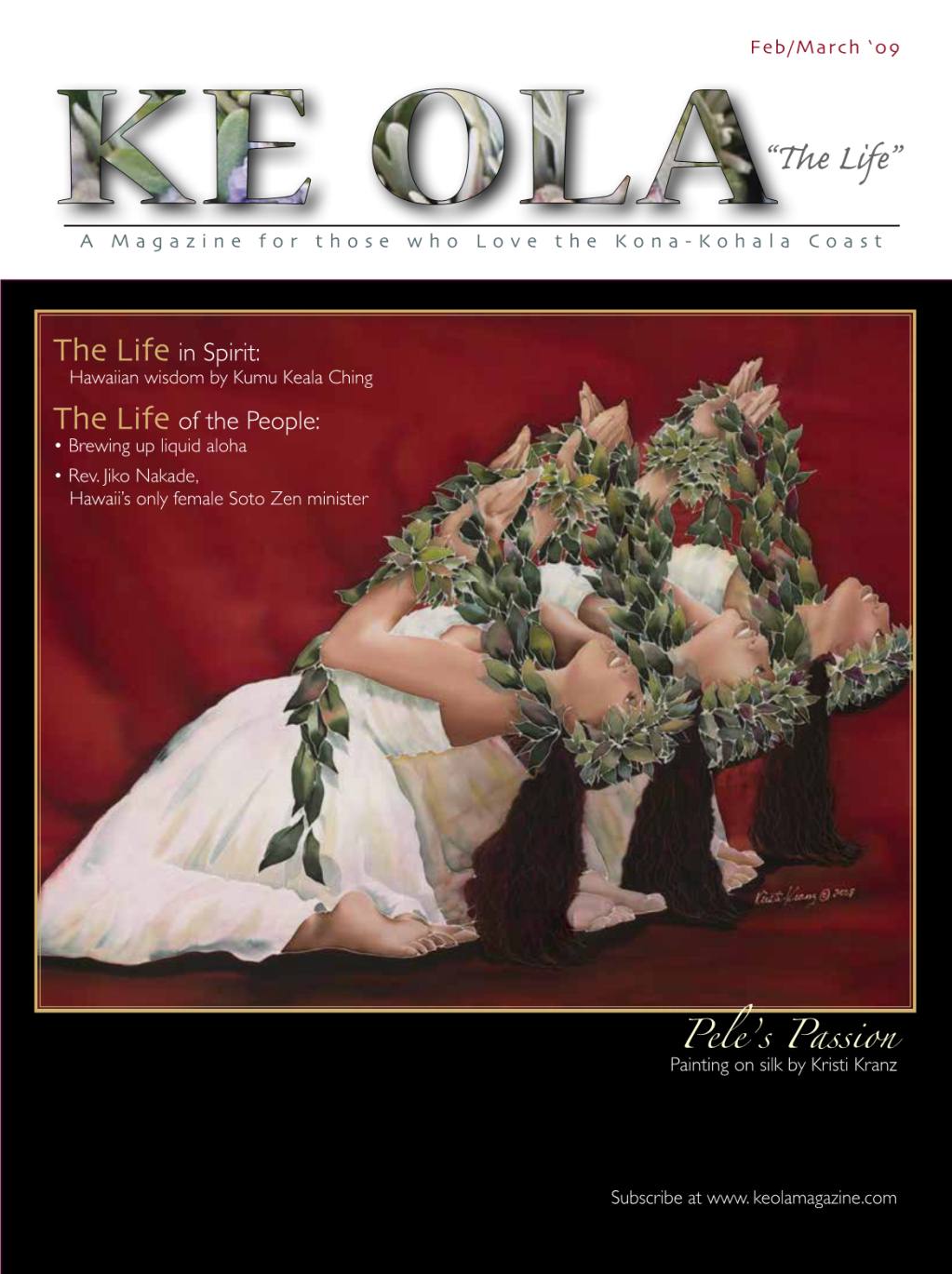
Raised in Seattle, Washington, and California, Kristi excelled in both art and sports in high school. She practiced both skills in Aspen, Colorado, where she supported her skiing habit during the ‘70s as a waitress, while painting watercolor portraits of Aspen’s Victorian homes for a local mapmaker. Then she forgot all about art for over a decade, following the dream of singing in a rock-and-roll band and landing on the Big Island in 1985 to help manage a small hotel in Kamuela. Her days were spent working as a fine-dining waitress and bartender, paddling and canoe racing.
A period of time owning a small clothing business based in Indonesia, Two Sisters Imports, introduced Kranz to the mystique of silk, and helped inspire her return to art. Beginning again with watercolor, she soon took on the complexities of silk painting.
Kranz’ first work on silk was, in fact, wearable art—hand-painted clothing. After developing that craft into a high-end, hand-painted silk clothing line—Kranz Silks— sold in boutiques on the Big Island and Honolulu, including Neiman Marcus, she found that was entirely too demanding.
“I thought I was going to die,” she said, reflecting on her schedule of production painting for Neiman Marcus.
Although her hand-painted silk clothing line may still be found in one Hawi boutique, original paintings now make up the bulk of Kranz’ work.
Customer demand, however, isn’t what directs her decisions of what to paint. “I won’t paint for the sale. I have to paint for me.”

Finding her inspirations in people and nature, she next painted silk panels in folding shoji screens, which glow in the light. Her silk wall hangings and shoji screens depict luminous visions of lush hideaways, waterfalls, ponds, flowers and dancers.
”I love to paint people and faces. That’s why I was attracted to hula dancers,” she says. Oriental themes inspired by old Chinese block prints—floral displays and the symmetry of swimming koi—also spring from her brush. The flavors of the Orient and Hawaii combine to give the silks their unique style.
“I’ve never lacked for inspiration,” she says. “I’ll see something and want to paint it. I’ll stand with my brush poised and wait to see what comes through me. I have this space where I’m not looking for anything, just painting, where stuff slips down from the universe, through me and onto my silk, and it brings me the most joy I’ve ever felt.” Kristi’s passion for painting is easy to feel. “I often find inspiration while paddling out on the water or running. I see so much and take it in. You know, that’s what it’s like, being an artist. What’s normal for others is striking to us.”
Yet, making a living as an artist rather than a waitress isn’t easy. In fact, it sometimes takes a miracle—or good teamwork—to match up the beautiful art with the buyer willing to make the investment.
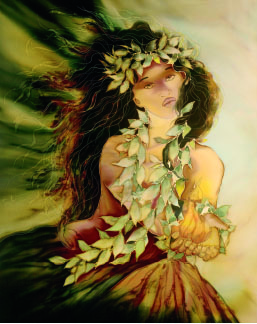
In 1995, serendipity put her in the same place with Gunner Mench, manager of Donatoni’s restaurant at the Hilton Waikoloa Village Resort, and he hired Kranz as a waitress. As fate would have it, he left there to buy Harbor Gallery in Kawaihae in 1997, and Kristi Kranz’ silk paintings and shoji screens soon had a place in the gallery.
“He promoted my work so well that I became his best-selling artist and was able to quit my $300-per-night job so that I could paint full time. Gunner’s ability to help people understand my art is the key. And it’s not only my art. He also helps support many other Big Island artists, as well,” she says.
Kranz puts a lot of herself into each silk painting, including some joy and a few tears, as the process is quite painstaking.
“Painting on silk isn’t always predictable. It teaches you,” Kranz says. “It does what it wants. If a mosquito bites you and you have a brush in your hand, the result may be good or not.”
She works on a horizontal surface, the silk pinned loosely at elbow height.
“The process requires that it be loose. Imagine a drop of wine spilled on a silk blouse on Thanksgiving Day.” It works like watercolor, yet the medium is a dye, not paint. Applied layer after layer, it builds up just the right amount of opacity and depth of color for the image. Kranz also uses the French serti technique, similar to batik, using a wax that blocks the spread of the color. Drawing an orchid, for example, with gutta, she outlines the design, and then fills it in with color. She uses Chinese bamboo brushes, which are versatile enough to make a fine line or a broad wash.
The silk itself comes exclusively from China, says Kranz, and she uses different varieties—from charmeuse to chiffon or habotai.
Mostly self-taught, Kristi learned from local artist Phan Barker in a day class and also spent some time apprenticing with several other artists.

When the painting is completed, the dye must be set; so another tricky process ensues, wherein the silk is wrapped around a pole, protected with a layer of paper or Pellon. The pole is placed into a steamer with boiling water, hot enough to allow the dye to molecularly bond with the silk, yet being careful not to over-saturate the silk, resulting in water spotting or bleeding. So, even at this late stage in the process, heartbreak can occur. Finally, after the steam bath, the fabric is washed to remove excess dye. This process results in a permanently-bonded painting that, in the case of clothing, is washable.
Kranz’ work can be found at a number of galleries around the islands, and she has private clientele, for whom she creates commissioned paintings, shoji screens and custom clothing.
Just this fall, she received a special request from Kahilu Theatre. As a fundraiser, the arts organization teamed up with Tiffany’s at the Kings’ Shops at Waikoloa to commission several local artists to create paintings on 20 ukuleles to be displayed and sold through the store in December and January. Kristi’s creation is a painting on silk, decoupaged onto the instrument.
She says she is pleased with the result, and given her continuing interest in music, she may be decorating more ukuleles and guitars. Or playing them in a local club. It’s just possible you may spot the artist as part of an all-girls-but-one-guy band playing at Luke’s in Hawi or at a local party. Contact Kristi Kranz at 808-889-6244 or email kranzsilks@aol.com. ❖


